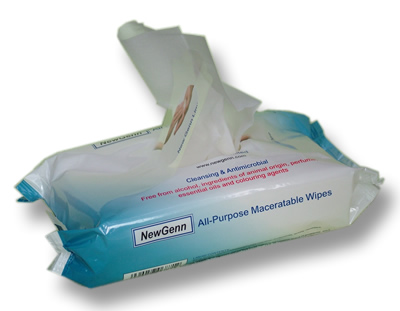According to the Mail's Victoria Fletcher:
Doctors call for a ban on face cream chemical blamed for an epidemic of skin allergies
** The chemical has been increasingly used in products since 2005 to extend there shelf life
** It is routinely added it to moisturisers, sun creams, shampoos and wet wipes
Doctors are calling for an immediate ban on a face cream chemical they say has triggered one of the worst skin allergy epidemics ever seen.
Cosmetics firms like MI because it extends the shelf life of their products. They routinely add it to moisturisers, sun creams, shampoos and wet wipes.
It is used in products including Nivea Daily Essentials face wipes, Piz Buin 1 Day Long Lotion, Clarins Extra-Firming Day Cream, L’Oreal RevitaLift Laser Renew, Molton Brown Paradisiac Pink Pepperpod Body Lotion and Wet Ones hand wipes.
Doctors blame the chemical for a massive surge in patients with rashes, scaling skin, swelling and eczema.
The problem will be discussed at a major dermatology conference in Liverpool this week.
There hasn’t been anything on this scale before. We just don’t know when it will peak.’
Two years ago, MI allergy, identified with skin patch testing, was virtually unknown. But this year 10 per cent of patients with certain skin conditions are testing positive, according to the St John’s Institute of Dermatology in London and Nottingham University Hospitals. Studies from Denmark and Australia paint a similar picture.
Dr John English, a consultant dermatologist at Nottingham University Hospitals said: ‘This is an epidemic and urgent, immediate action is needed. Every day we are seeing patients who are allergic to this chemical. Patients don’t realise it’s their cosmetics causing the problem so they keep on using them.’
Manufacturers started to use MI seriously about five years ago after it was approved by the European Commission as a preservative for products left on the skin in 2005. At the time, the available data suggested it was safe. Experts say the true scale of the problem has only come to light as a result of it being used by millions of people.
The preservative stops products going mouldy by binding to microbes, preventing the bugs from thriving. However, the immune systems of some people mistakenly identify MI as a threat, prompting an allergic reaction.
Molton Brown said last night it would stop using MI from September. L’Oreal, Clarins and Wet Ones said their products were safe.
An EC spokesman said its scientists were looking into the concerns ‘in detail’.
Some of the products involved are listed in this pic (below), including Wet Ones; Head and Shoulders Anti-Dandruff Smooth and Silky Conditioner; Dove Men; Clarins Extra-Firming Day Cream; Nivea Lotion and Brylcreem Gel.
 |
| A list copied from The Mail of the relevant products |
Also:
Re wet wipes, here's an alarming link:
http://www.guardian.co.uk/environment/shortcuts/2012/oct/26/wet-wipes-wreaking-havoc-sewers
Time was when British bottoms were built to withstand the crinkliest, shiniest toilet paper available, and in some cases even to enjoy it. But there has been a fundamental softening in recent years, seen in a growing preference not only for quilted loo roll, but now for wet wipes.
The musician Will.i.Am is one leading exponent of damp bottom-wiping. The consequences for our drains, though, are disastrous.
If you swill a piece of toilet roll around in some water, it takes seconds for it to disintegrate. Wet wipes should never be put down drains, because they don't break down – even if the packaging says they are 'biodegradable' or 'flushable'. Only human waste and loo roll should go down our sewers."
Ignoring this advice causes blockages, especially in suburban areas where the pipes are narrowest – anything from 6in to 12in in diameter. And blockages cause unspeakable things. It can result in sewage backing up on to streets, into gardens, into parks and in some cases – around 1,000 a year – sewage backs up into people's homes which is one of the most vile things that can ever happen to you.
And whilst we're on this subject - are disposable nappies good or bad?
Even so-called 'eco-friendly' nappies labelled biodegradable do not biodegrade in landfills and cause just as much of a problem as regular nappies.
They are also a breeding ground for disease which could potentially enter our water courses. Apparently it's recommended that the poo is flushed off nappies before they're put into the waste so that the poo can be treated. But the wee should also be disposed of before the nappy is thrown away but I should imagine that's nearly impossible.
Some misconceptions about terry nappies: http://www.totnesnappycompany.
co.uk/index.php/common-misconceptions
co.uk/index.php/common-misconceptions
And another view about terry nappies: http://www.minti.com/parenting-advice/5787/My-experiences-using-flat-nappies/
I used terry nappies as disposables around in those days were unreliable and expensive, so there was no decision to make. They weren't much bother to soak, wash and dry. 
Thank you for highlighting the problems of wet wipes and (my pet loathing) disposable nappies.
ReplyDeleteI have never understood why anyone would think the disposable nappy was better than the terry option. Every collection day I see the wagon emptying the non-recyclable waste (fortnightly) and wonder just what percentage of the load amounts to these things.
Even ignoring the appalling volume of waste these things produce, I can never understand why anyone would waste their money. Two packs of terry nappies out-lasted the requirements of both my young 'uns. The question of washing is hardly an argument these days as the machine washes and dries them - and there is no ironing. And what about the infant's comfort? I know of no mother or father who chooses to wear plastic underwear which they dispose of at the end of the day as it is more convenient and I'm sure they never will, considering the consequences.
I would like to see an adequate supply of terry nappies GIVEN to the parents of each newborn and heavy taxes imposed on so-called 'disposables', at least that would go some way to paying for dealing with them.